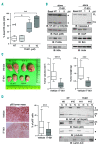Targeting metabolism and survival in chronic lymphocytic leukemia and Richter syndrome cells by a novel NF-κB inhibitor
- PMID: 28860341
- PMCID: PMC5664392
- DOI: 10.3324/haematol.2017.173419
Targeting metabolism and survival in chronic lymphocytic leukemia and Richter syndrome cells by a novel NF-κB inhibitor
Abstract
IT-901 is a novel and selective NF-κB inhibitor with promising activity in pre-clinical models. Here we show that treatment of chronic lymphocytic leukemia cells (CLL) with IT-901 effectively interrupts NF-κB transcriptional activity. CLL cells exposed to the drug display elevated mitochondrial reactive oxygen species, which damage mitochondria, limit oxidative phosphorylation and ATP production, and activate intrinsic apoptosis. Inhibition of NF-κB signaling in stromal and myeloid cells, both tumor-supportive elements, fails to induce apoptosis, but impairs NF-κB-driven expression of molecules involved in cell-cell contacts and immune responses, essential elements in creating a pro-leukemic niche. The consequence is that accessory cells do not protect CLL cells from IT-901-induced apoptosis. In this context, IT-901 shows synergistic activity with ibrutinib, arguing in favor of combination strategies. IT-901 is also effective in primary cells from patients with Richter syndrome (RS). Its anti-tumor properties are confirmed in xenograft models of CLL and in RS patient-derived xenografts, with documented NF-κB inhibition and significant reduction of tumor burden. Together, these results provide pre-clinical proof of principle for IT-901 as a potential new drug in CLL and RS.
Copyright© Ferrata Storti Foundation.
Figures








References
-
- Karin M, Lin A. NF-kappaB at the crossroads of life and death. Nat Immunol. 2002;3(3):221–227. - PubMed
-
- Perkins ND, Gilmore TD. Good cop, bad cop: the different faces of NF-kappaB. Cell Death Differ. 2006;13(5):759–772. - PubMed
-
- Hayden MS, Ghosh S. Shared principles in NF-kappaB signaling. Cell. 2008;132(3):344–362. - PubMed
-
- Vallabhapurapu S, Karin M. Regulation and function of NF-kappaB transcription factors in the immune system. Annu Rev Immunol. 2009;27:693–733. - PubMed
MeSH terms
Substances
LinkOut - more resources
Full Text Sources
Other Literature Sources

